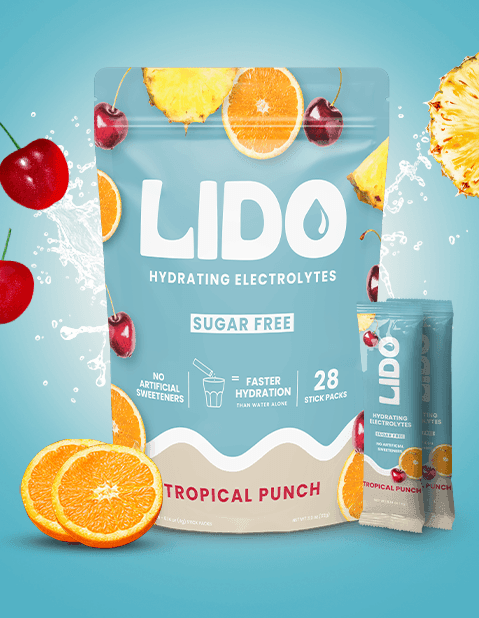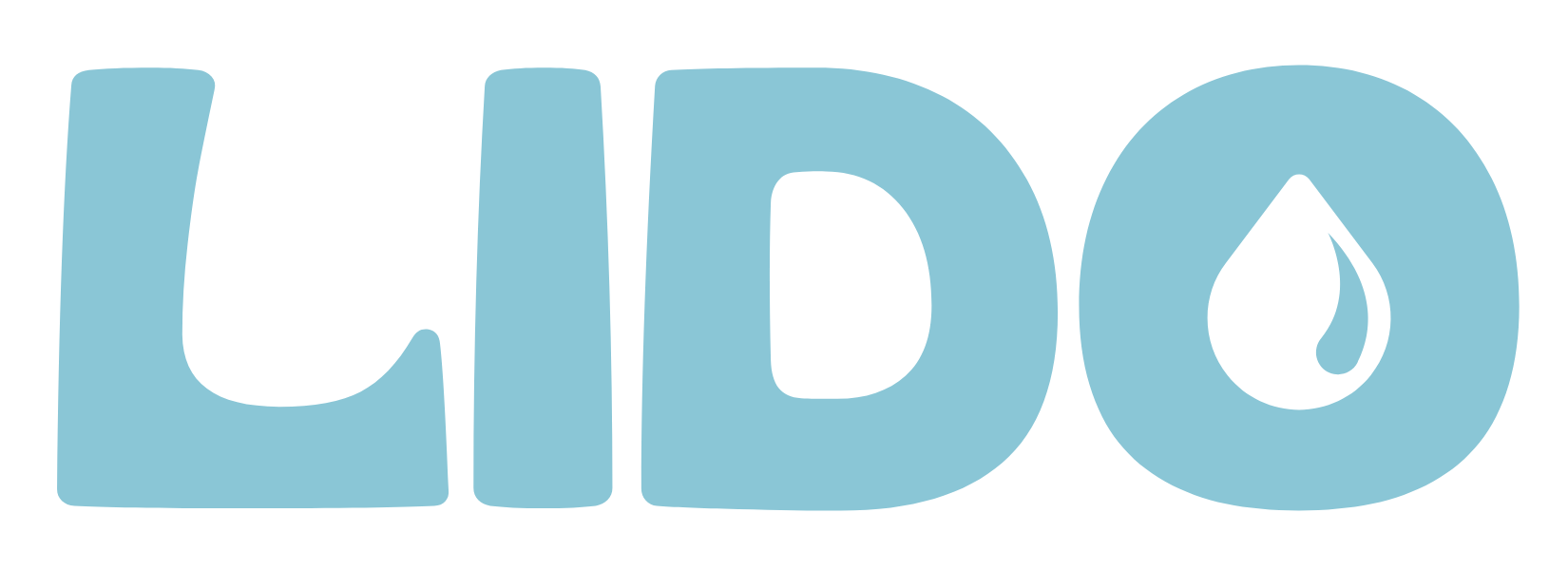How Electrolyte Loss Causes Keto Flu & How to Cure It
Jennifer DouglasShare

Imagine losing weight simply by eating high-fat, low-carb foods every day. That’s the main selling point of the ketogenic diet—better known as “keto”—and why it’s so popular. Beyond jump-starting weight loss, this buzzy eating hack promises plenty of other health benefits for those who adopt it. But before you start scouring the internet for keto recipes, be aware that the keto journey isn’t always smooth sailing (at least at the beginning).
Many keto beginners report feeling sluggish, achy, and run-down within the first few weeks of going keto (as if starting a new diet isn’t challenging enough). That strange under-the-weather feeling results from the so-called “keto flu.” This isn’t the real flu but a natural response to the body switching to a new fuel source and its electrolyte levels plummeting.
As electrolyte aficionados, we couldn’t resist exploring the link between keto flu and electrolyte loss. So, in this guide, we’ll explain the science behind keto flu, how electrolyte deficiency may trigger it, and the role of electrolytes in preventing and alleviating the dreaded keto flu symptoms. We’ll also reveal the best keto-friendly electrolytes to incorporate into your ketogenic diet to keep your energy up.
What exactly is the Keto Diet?
The popular keto diet (short for “ketogenic diet”) is an eating pattern that involves cutting the amount of carbs you consume and replacing them with fat and low to moderate intakes of protein. Interestingly, keto was originally developed to treat epilepsy but has gained prominence for supporting weight management, cardiovascular health, cognitive function, and sleep optimization.
According to StatPearls, a standard keto diet comprises 70% to 80% fat, 10% to 20% protein, and 5% to 10% carbohydrates. The idea behind this diet is that cutting ties with carbs (your primary energy source) forces the body to burn fat for fuel. More scientifically, “The whole point of the keto diet is to enter and then remain in the metabolic state called ketosis, in which you burn fat for energy, rather than carbohydrates (glucose),” explains Dr. Josh Axe, a certified doctor of natural medicine and clinical nutritionist.
How the Keto Diet Works
The body needs energy for everything it does—and even at rest. In a typical Western diet, the glucose from carbs (such as grains, legumes, vegetables, and fruits) supplies most of that energy. However, Russell H. Swerdlow, M.D., professor of neurology, biochemistry, and physiology at the KU School of Medicine, says that in keto diets, where carbs are minimal, “the body draws its energy from dietary fat and the body’s fat storage, which produces ketone bodies.”
Typically, the liver converts carbohydrates to glucose to fuel the body. But when there isn’t enough glucose (like on keto), the body breaks down stored fat. To do so, the liver turns fat into ketones, which can be used for energy without glucose. When your body burns fat this way, it enters a state of ketosis.
WebMD says ketosis usually kicks in after 3 or 4 days of eating fewer than 50 grams of carbohydrates per day in healthy people who don’t have diabetes and aren’t pregnant. The body works fine using ketones and will continue burning fat until carbs (or too much protein) are reintroduced into the diet.
Keto Flu: What It Is and Signs You May Have It
You’ll often see complaints about “keto flu” or “carb flu” on keto forums and blogs, and that’s because it’s a real problem for many new keto dieters. Since the keto diet involves banishing as many carbs from the diet as possible, some people may undergo a “carbohydrate withdrawal” or “adjustment period,” aka., the keto flu, explains Priyanka Hennis, M.D., a family physician in Phoenix, Arizona.
In essence, your body burns carbohydrates (glucose) for energy by default, so switching to a fat-burning process confuses it. It makes sense because most of us likely spent the last 20-30 years of our lives eating high-carb and -sugar diet. Since our bodies aren’t used to using a fat-dependent energy source, they may throw a tantrum and resist the changes with keto. This often manifests as a range of symptoms that can feel quite similar to the influenza virus. Also, the brain works best when fueled by glucose from carbs, so a low-carb diet like keto may cause confusion and irritability.
Common Symptoms of the Keto Flu
As your body transitions to burning fat for fuel, you may experience several symptoms, most likely manifesting keto flu. According to Abbey Sharp, a registered dietician and nutrition blogger, “You tend to experience brain fog, headaches, nausea, and fatigue, along with bad-smelling breath, sweat, and urine. We also tend to see a big drop in our electrolyte levels as we lose water weight, which also makes us feel crummy.”
One study outlines several other frequently reported keto flu symptoms, including:
- Brain fog
- Dizziness
- Muscle cramping and soreness
- Poor focus and concentration
- Diarrhea or constipation
- Trouble falling asleep or staying asleep
- Heartbeat alterations
- Gastrointestinal discomfort
- Decreased energy
- Sugar cravings
Intermountain Health says these keto flu symptoms may start within the first day or two of eliminating carbs and can last a week or less (often long enough to encourage dieters to call it quits). However, they can persist for up to a month in extreme cases. The length of time depends on how your body responds to the diet and genetics. Still, some (lucky) people can switch to a ketogenic diet without experiencing those bothersome keto flu symptoms. Supposedly, that’s because they are naturally “metabolically flexible.”
How Electrolyte Deficiency Can Cause Keto Flu
Some keto diets are incredibly restrictive, which means you might be cutting out some of the richest natural sources of electrolytes, thus increasing your risk of developing the keto flu. So, while many keto dieters are often quick to blame their keto flu symptoms on low blood sugar or the transition to using ketones for brain fuel, it could well be an electrolyte deficiency.
Electrolytes are minerals that carry an electric charge when dissolved in fluids like blood. They are crucial for body processes like conducting nerve impulses, contracting muscles, hydrating, and regulating pH levels. However, when your carbs stores dry up during keto, your body undergoes several metabolic changes, including how it handles electrolytes.
Drastically reducing your carbs means the pancreas produces less insulin, a hormone that helps the body absorb glucose from the blood. When insulin levels are lower, the kidneys expel more sodium and potassium through urine. Similarly, the keto diet restricts the intake of sugary fruits, beans, and starchy vegetables, which are high in potassium and magnesium. Failing to replenish these lost electrolytes often leads to some of the keto flu’s symptoms, such as headaches, difficulty sleeping, and muscle cramps.
Furthermore, when we eat carbs, the energy we do not use immediately is stored as glycogen molecules, with each gram (g) of glycogen binding to 3g of water. Since carbs store much of the body’s retained water, a diet restricting carb intake means the body releases more water than usual through urine (or sweat)—which explains why some people lose “water weight” at the beginning of keto or when they lower their carb intake. And since ketones can act as a mild diuretic, you may have frequent urination and potential dehydration.
How Do Electrolytes Help Reduce Keto Flu Symptoms?
If you look up the consequences of sodium, magnesium, potassium, and calcium deficiency, you’ll see a lot of familiar symptoms—headaches, muscle cramps, dizziness, weakness, brain fog, insomnia, etc. Luckily, many of these symptoms can be minimized or eliminated by replenishing your electrolytes, specifically those minerals mentioned earlier.
Here’s how these particular electrolytes could help alleviate your keto flu symptoms:
1. Sodium
Sodium is the most abundant and most important electrolyte in the body. Many people often confuse it with salt, but it’s a component of salt that has widespread functions and plays a massively vital role in health.
Intermountain Healthcare says the body needs sodium to maintain fluid balance, support nerve and muscle function, help cells absorb nutrients, and more. Unfortunately, low sodium is probably the most common deficiency for low-carb eaters, which the National Kidney Association says can exhibit many keto-flu-like symptoms, including:
- Nausea and vomiting
- Headache
- Frequent muscle weakness, spasms (twitching), or cramps
- Low blood pressure
- Dizziness when standing up
- Low energy or fatigue
- Loss of appetite
- Restlessness or lousy temper
Bumping up your sodium intake will likely fix many cases of keto flu.
2. Potassium
Potassium is best known for its presence in bananas, but you can also consider it the “yin” to sodium’s “yang.” This mineral, along with sodium, is vital for regulating blood pressure and aiding muscle function, so it’s no surprise that potassium deficiency is linked to symptoms such as:
- muscle cramps
- muscle twitching
- abnormal heart rhythms (arrhythmia)
- feeling tired
- weakness and fatigue
As many potassium-rich foods are high in carbohydrates (think bananas, sweet potatoes, and lentils), individuals on a ketogenic diet may need more potassium. Consuming more potassium (without the extra carbs) may help restore this balance and remedy the symptoms.
3. Magnesium
Magnesium wears hundreds of hats in the body. It’s involved in over 300 enzymatic reactions, from regulating blood pressure and turning food into energy to supporting healthy bones and improving muscle and cognitive function. With that many functions and responsibilities, you can understand why magnesium deficiency can lead to the following symptoms:
- Muscle cramps (particularly in the legs)
- Insomnia
- Depression
- Anxiety
- Confusion
The good news is that consuming sufficient magnesium can help remedy these issues during the adaptation phase of a ketogenic diet.
4. Calcium
While not always emphasized in discussions about keto flu, calcium is essential for bone health and muscle contractions. An imbalance in calcium levels can exacerbate symptoms that are eerily similar to those associated with keto flu. These include:
- Muscle cramps
- Muscle twitching
- Weakness
- Fatigue
- Irritability
- Sensations of pins and needles
Maintaining adequate calcium intake through dairy or fortified alternatives is essential for overall health during dietary changes.
What’s the Ideal Electrolyte Balance for Keto?
The body needs a good balance of electrolytes to function correctly (and ward off those annoying keto flu symptoms). Therefore, each electrolyte must be kept in a healthy range, which can be a struggle when you start a ketogenic diet.
Below is a list of essential electrolytes you need on keto and how much you need for each mineral (your normal electrolyte levels, according to Cleveland Clinic):
- Sodium: 136 to 144 mmol/L
- Potassium:7 to 5.1 mmol/L
- Calcium: In adults, 8.5 to 10.2 mg/dL
- Chloride: 97 to 105 mmol/L
- Magnesium:7 to 2.2 mg/dL
- Phosphate:5 to 4.8 mg/dL
- Bicarbonate: 22 to 30 mmol/L
How to Incorporate More Electrolytes into Your Keto Diet to Alleviate Keto Flu Symptoms
If you suddenly come down with keto flu, there’s no magic cure to make it go away instantly. There are, however, some steps to turn weeks of keto flu symptoms into a single day or mere hour, if any at all. And guess what? It’s as simple as keeping your electrolytes in a healthy range.
Here’s how to boost your hydration and electrolyte levels on keto:
- Stay hydrated.
With all the excess fluids lost from cutting carbs, you’ll need to drink lots of water to replenish them once you start keto. One way to remember to drink up is to set reminders on your phone, always keep a full glass of water in reach, or fill up your water bottle and bring it with you wherever you go. Most people don’t know how much water to drink, but it’s easy to calculate your daily water intake needs.
Related: 8 Simple Ways to Stay Hydrated Every Day
- Eat more whole foods that are keto-friendly and rich in electrolytes.
Foods naturally rich in electrolytes should always be your go-to electrolyte source. But given keto’s low-carb restriction, sweet potatoes, quinoa, lentils, etc., are off-limits. Instead, opt for keto-friendly foods with little to no carbs, higher fat content, and a substantial amount of protein, such as the following:
| Electrolyte | Food Sources |
| Sodium | olives, pickles, bone broth, tomato juice, sauce, or soup, table salt (add raw to vegetables or meals or drinking water) |
| Potassium | avocado, almonds, leafy greens (spinach, kale, Swiss chard), broccoli, brussels sprouts, mushrooms (portobello, white), pumpkin seeds, salmon |
| Magnesium | nuts (almonds, macadamia nuts), pumpkin seeds, dark chocolate, spinach and other leafy greens, salmon or halibut |
| Calcium | Dairy, dark leafy greens (kale, collard greens), almonds |
| Chloride | table salt, seaweed, tomatoes |
Related: Healthy Foods That are High in Magnesium and Potassium
- Take an electrolyte supplement.
If you are physically active during your keto diet or have frequent vomiting or diarrhea, electrolytes from whole food likely won’t be enough to bump up your levels and ward off keto flu. This is truer for athletes, as they tend to excrete higher amounts of electrolytes through sweat, leading to a further loss of sodium, magnesium, and potassium. For this reason, you might want to consider a commercially available electrolyte supplement on top of your diet.
Electrolyte powders are a convenient way to supplement your electrolytes. They can help maintain hydration balance, support muscle function, ensure good heart health, and boost mental clarity. They also offer a quick boost to your workout performance and recovery to keep you on top of your game.
Related: Electrolytes: The Secret to a Healthier Pregnancy?
The Best Electrolyte Powder for Keto Flu Relief
Electrolyte powders offer a super-easy way to boost your electrolytes, but you must be careful about what brand you choose. Some electrolyte powders are jam-packed with sugars, glucose, corn syrup, and artificial ingredients that could sabotage your health and keto goal(s). That’s why Lido sugar-free electrolyte powders are perfect for keto dieters and those concerned about health.
Lido’s electrolyte mixes are carefully formulated with essential electrolytes to help you perk back up and get your energy and vibrance back on keto. Each electrolyte stick pack contains sodium, magnesium, and potassium and comes in various delicious flavors (like Watermelon and Lemonade) to make hydrating easier and more enjoyable. Beyond that, they contain zero sugar and are made with natural fruit extracts, pure Himalayan pink salt, and vegan- and keto-friendly ingredients. They also don’t contain artificial colors, flavors, or other garbage ingredients.
Learn more: Himalayan Pink Salt Benefits: Better than Regular Salt?
Final Thoughts on Keto Flu and Electrolyte Deficiency
If you’ve hopped on the keto train recently or are considering doing so, know that it isn’t all weight loss and roses. Besides the challenge of starting a new diet, you may experience the keto flu. With symptoms from tiredness and brain fog to muscle cramps and headaches, dealing with this condition can be frustrating. However, there’s an easy way to alleviate the symptoms or prevent them in the first place: replenishing your electrolytes. While nothing beats a keto-friendly diet rich in electrolyte-dense whole foods, you might need to try supplements like Lido’s sugar-free, keto-friendly electrolyte powders for your daily electrolyte fix in certain situations.
Frequently Asked Questions about Keto Flu and Electrolytes
- How long does keto flu typically last?
Keto flu can feel rough, but don’t worry—it usually doesn’t last forever! Most people start feeling symptoms within the first few days of going keto. WebMD says you might feel crummy for about one to two weeks after beginning a keto diet, but if your keto symptoms last for 10 days or are overly painful or debilitating, you may want to reach out to your physician.
- Can I overdose on electrolytes?
Yes, you can! As much as electrolytes are essential for your health, too much can harm our health, the American Heart Association (AHA) warns. Overdoing it on electrolytes like sodium, potassium, or magnesium can lead to imbalances, with symptoms that can include nausea, weakness, or even heart issues. With that in mind, try to maintain the recommended electrolyte levels. Your doctor should be able to help with this.
- Are there any side effects of using electrolyte powders?
Electrolyte powders can be a tremendous keto flu remedy, but they can also come with some side effects if you’re not careful. While rare, some people might experience tummy troubles like bloating or diarrhea. Some powders have added sugars or artificial ingredients that might not sit well with everyone. Always check the label and start with a small amount, or consult your physician for guidance.
- How quickly can I expect relief from keto flu symptoms after electrolyte supplementation?
If you start taking electrolytes, you might feel better quickly. Many people notice improvements within 24 to 48 hours. However, it could take a little longer—up to a week or so—before all those pesky symptoms disappear. Just hang in there; relief is on the way!
- Who’s More Likely to Get the Keto Flu?
According to Mary Wirtz, a Colorado-based clinical registered dietitian and board-certified specialist in sports dietetics, keto flu symptoms are pretty common in individuals beginning a ketogenic diet and can be worse if the person isn’t staying well hydrated. But not everyone who tries a keto diet will experience keto flu symptoms, says Nicole Roach, a registered dietitian at Lenox Hill Hospital in New York—it depends on the individual.





